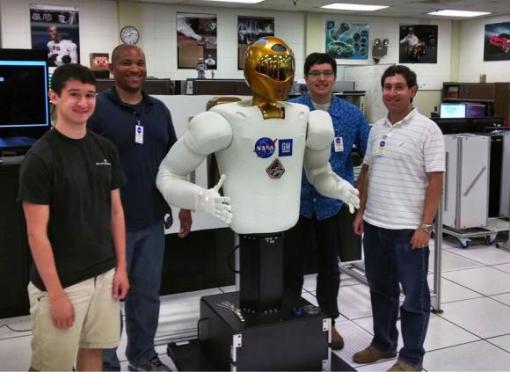
As robots become more capable, their software becomes more complex. A hackathon team — from left, Matt Wong, Chad Jenkins, David Lu, and John Raiti — worked for a week at NASA to lay the groundwork for a simpler web-based interface for remote control of robots.
Computer scientists from Brown University and the University of Texas–Austin visited NASA's Johnson Space Center for a week-long hackathon to provide computers and tablets with a simple web interface that can operate complex systems for the remote control of robots.
PROVIDENCE, R.I. [Brown University] — A group of computer scientists from Brown were at the Johnson Space Center in Houston last week for a week-long marathon of intensive coding to build new software for the Robonaut 2 and other NASA robots.
The coding marathon, known in the computer science vernacular as a hackathon, was a partnership between NASA, Brown, and the University of Texas–Austin. The work was part of a NASA grant awarded recently to Chad Jenkins, associate professor of computer science and engineering at Brown.
Jenkins' lab builds user interfaces that can control robots of all kinds with an off-the-shelf web browser. The system can be adapted for even the most complex robots, and NASA wants Jenkins and his team to adapt the interface for the humanoid robot, Robonaut 2 — "R2."
As it is now, R2 can be controlled only from computers with specialized software that can communicate with R2's operating system. The interface Jenkins and his team are developing creates a software bridge that enables a web browser to communicate with that operating system. That means all of the R2's complex capabilities could be accessed from virtually any computer or even from tablets.
The goal of last week's hackathon was to lay the groundwork for the project. Jenkins was joined at the hackathon by research scientist John Raiti, undergraduate student Matt Wong, and David Lu, a researcher from Washington University working with Jenkins's lab.
"Before the hackathon started we only had a first pass of a web interface," Raiti said. "But by the end we were able to demonstrate through simulation a working interface for control of the Robonaut 2."
By simulation, Raiti is referring to a virtual version of R2 that runs on a computer server. Operating the real thing comes later.
There are currently two R2s, one aboard the International Space Station and one operating at the Johnson Space Center. The earthbound version is used to test code and do safety checks for the orbiting version. The new web interface will enable the R2 on earth to be controlled from a Web connection anywhere. Astronauts could control the orbiting R2 with nothing more than a tablet.
Matt Wong, a rising senior and computer science concentrator, relished the chance work on the project and make the trip to Johnson Space Center. His work on the project this summer was supported by Brown's Karen T. Romer Undergraduate Teaching and Research Awards program.
"The hackathon also gave me an opportunity to meet more people involved with robotics, as we worked alongside several NASA employees as well as a group from UT–Austin," Wong said. "It was a really rewarding experience."
He and his fellow hackers churned out thousands of lines of code during the week. The group was pleased with what they were able to accomplish.
"Most of the work I did at the hackathon revolved around setting up the basic structure to enable communication between our [browser-based] front-end and the back-end server on which robot code actually runs," Wong said. "We made good progress at the hackathon, but there's still a good amount of work to be done before the web interface is fully functional."
Wong said he looks forward to continuing his work on the project when school starts again.
For Jenkins, the R2 project is part of a broader effort to make robots more accessible to more people. His lab has already designed web interfaces that can control the PR2 household assistance robot, quadricopter drones, and other devices.
"The idea is that we want to be able to make robots available to everybody in the world through the Internet, using the web browser," Jenkins said. "This is our way of getting robots out of the lab and into the world."
- by Kevin Stacey